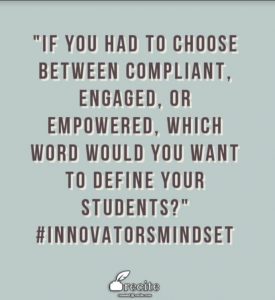Recently in a meeting, I made the statement, “Compliance is not “ok” with me.” When I made the statement, there were many responses both aloud and quietly. I was surprised that my statement evoked such a response. The negative undertones were apparent and I did not make a connection until I read this quote from George Couros’ Blog. I thought, “exactly.” Sometimes we are happy that someone is doing as we asked but compliance is a minimal expectation in my opinion.
 From George Couros’ Blog: #INNOVATORSMINDSET
From George Couros’ Blog: #INNOVATORSMINDSET
In my mind, when I think of compliance–I see this graphic:
| Compliance———–Engaged——–Successful——-Empowered
|
When you think of these words in this manner. Where do you want students to be? Where do you as a teacher want to be?
When a new concept is taught, we look for compliance or can they do it. This does not mean doing something well; it means–getting it done or checking it off a list. With practice things become comfortable, a learner becomes involved/engaged. This to me is the practice stage. Successful is simply being able to master a concept but what we truly want is empowered. This means they have the ability to do something and implies motivation to do.
Motivation paired with the ability to do—is true learning. How many students can we think of that have the ability but simply will not do? How many of our students want to do but don’t have the skills?
Building a learner’s motivation is just as important as the automaticity of the skills.
How do we build this motivation? A 3 Step Process.
- Repetition: We must repetitively teach content and strategies. We sometimes think that is boring so we want to change up our teaching BUT the brain likes repetition and that is how it learns. Remember it takes 24 exposures for something to “stick” but can be up to 100 for students struggling with a concept.This repetition builds automaticity or what some people refer to as procedural fluency.
- Accountability and Expectations: We must hold our students accountable to what we ask. This is the expectation and therefore, our students must work to meet our “challenge” even when it is hard. If it is hard a teacher can add scaffolding while learning a concept but our goal is to remove that help slowly so a student masters the concept or skill independently without support. When things get tough–accountability is key.
- Reflection and Feedback: Students must have time to reflect on their performance and learn to know if they were successful. If they were successful–what is the next step? If they are not successful–where can I improve? It is this reflection that is paired with the feedback of a teacher that helps a student set goals and meet them. The process of reflecting and making changes from feedback creates motivation for the learner and without it—they know how to do it but don’t.
Think about your classroom–are these steps in place? If you want truly empowered learners–find the pieces that need to be strengthened and take action.